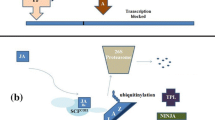Abstract
There is a general understanding about the different kinds of induced defensive reactions in herbaceous plants, and some hypotheses have been proposed for the possible mechanisms of their induction (Sequeira 1983, Darvill and Albersheim 1984). Two reactions have been distinguished: a localized one and a systemic one. The localized or hypersensitive reaction is seen only in close proximity to the site of wounding and is characterized by a local accumulation of phytoalexins. This reaction is generally caused by the presence of microorganisms (bacteria or fungi) in the wound because sterile wounds do not exhibit this kind of response. Phytoalexins, which play an important role in restricting the extent of penetration by the microorganisms, are released by host plant cells in response to various elicitors, usually compounds from pathogen or plant cell walls (Hadwigeret al. 1981, Sequeira 1983, Darvill and Albersheim 1984). These elicitors are nonspecific and are generally polysaccharides or glycoproteins. The systemic reaction is observed at sites in the host-plant distant from the point of damage or infection and some time after its induction. In these circumstances, the plant is usually more resistant to a challenge inoculation after the original inducing inoculation than to the original one itself. The elicitors responsible for this reaction originate from broken cell walls of the plant and diffuse throughout the plant. They can be released by a simple wound that is caused, for example, by the feeding of chewing phytophagous insects (Ryanet al. 1985).
Access this chapter
Tax calculation will be finalised at checkout
Purchases are for personal use only
Preview
Unable to display preview. Download preview PDF.
Similar content being viewed by others
References
Baltensweiler, W., G. Benz, P. Bovey, and V. Delucchi. 1977. Dynamics of larch bud moth populations. Annu. Rev. Entomol. 22: 79–100.
Berryman, A. A. 1969. Responses ofAbies grandis to attack byScolvtus ventralis (Coleoptera: Scolytidae). Can. Entomol. 101: 1033–1041.
Berryman, A. A. 1972. Resistance of conifers to invasion by bark beetle-fungus associations. Bioscience 22: 599–601.
Coutts, M. P. and J. E. Dolezal. 1966. Polyphenols and resin in the resistance mechanism ofPinus radiata attacked by the wood wasp,Sirex noctilio and its associated fungus. Commonwealth Australia, Forestry and Timber Bureau Leaflet 101, 19 p.
Darvill, A. G. and P. Albersheim. 1984. Phytoalexins and their elicitors—a defense against microbial infection in plants. Annu. Rev. Plant Physiol. 35: 243–275.
Green, T. R. and C. A. Ryan. 1972. Wound-induced proteinase inhibitor in tomato leaves. Plant Physiol. 51: 19–21.
Hadwiger, L. A. and J. M. Beckman. 1980. Chitosan as a component of pea-Fusarium solani interactions. Plant Physiol. 66: 205–211.
Hadwiger, L. A., J. M. Beckman, and M. J. Adams. 1981. Localization of fungal components in the pea-Fusarium interaction detected immunochemically with anti-chitosan and anti-fungal cell wall antisera. Plant Physiol. 67: 170–175.
Lieutier, F. and A. A. Berryman. 1987. (In press). Histology of the defense reactions of three pine species toCeratocvstisclavigera and two chemical elicitors. Can. J. For. Res.
Miller, R. W., A. A. Berryman, and C. A. Ryan. 1986. Biotic elicitors of defense reactions in lodgepole pine. Phytochemistry 255: 611–612.
Nothnagel, E. A., M. McNeil, P. Albersheim, and A. Dell. 1983. Host- pathogen interactions. XXII. A galacturonic acid oligosaccharide from plant cell walls elicits phytoalexins. Plant Physiol. 71: 916–926.
Reid, R. W., H. S. Whitney, and J. A. Watson. 1967. Reactions of lodgepole pine to attack byDendroctonus ponderosae Hopkins and blue stain fungi. Can. J. Bot. 46: 1115–1126.
Ryan, C. A., P. D. Bishop, M. Walker-Simmons, W. E. Brown, and J. S. Graham. 1985. Pectic fragments regulate the expression of proteinase inhibitor genes in plants. In: Cellular and molecular biology of plant stress (A. R. Liss, Ed. ); 319–334.
Sequeira, L. 1983. Mechanisms of induced resistance in plants. Annu. Rev. Microbiol. 37: 51–79.
Shain, L. 1971. The response of sapwood of Norway spruce to infection byFomes annosus. Phytopathology. 61: 301–307.
Shain, L. and W. E. Hillis. 1971. Phenolic extractives of Norway spruce and their effects onFomes annosus. Phytopathology. 61: 841–845.
Walker-Simmons, M., L. Hadwiger, and C. A. Ryan. 1983. Chitosans and pectic polysaccharides both induce accumulation of the antifungal phytoalexin pisatin in pea pods and antinutrient proteinase inhibitors in tomato leaves. Biochem. Biophys. Res. Commun. 110: 194–199.
Wong, B. L. and A. A. Berryman. 1977. Host resistance to the fir engraver beetle. 3. Lesion development and containment of infection by resistantAbies grandis inoculated withTrichosporium symbioticum. Can J. Bot. 55: 2358–2365.
Editor information
Editors and Affiliations
Rights and permissions
Copyright information
© 1988 Springer-Verlag New York Inc.
About this paper
Cite this paper
Lieutier, F., Berryman, A.A. (1988). Elicitation of Defensive Reactions in Conifers. In: Mattson, W.J., Levieux, J., Bernard-Dagan, C. (eds) Mechanisms of Woody Plant Defenses Against Insects. Springer, New York, NY. https://doi.org/10.1007/978-1-4612-3828-7_21
Download citation
DOI: https://doi.org/10.1007/978-1-4612-3828-7_21
Publisher Name: Springer, New York, NY
Print ISBN: 978-1-4612-8368-3
Online ISBN: 978-1-4612-3828-7
eBook Packages: Springer Book Archive




